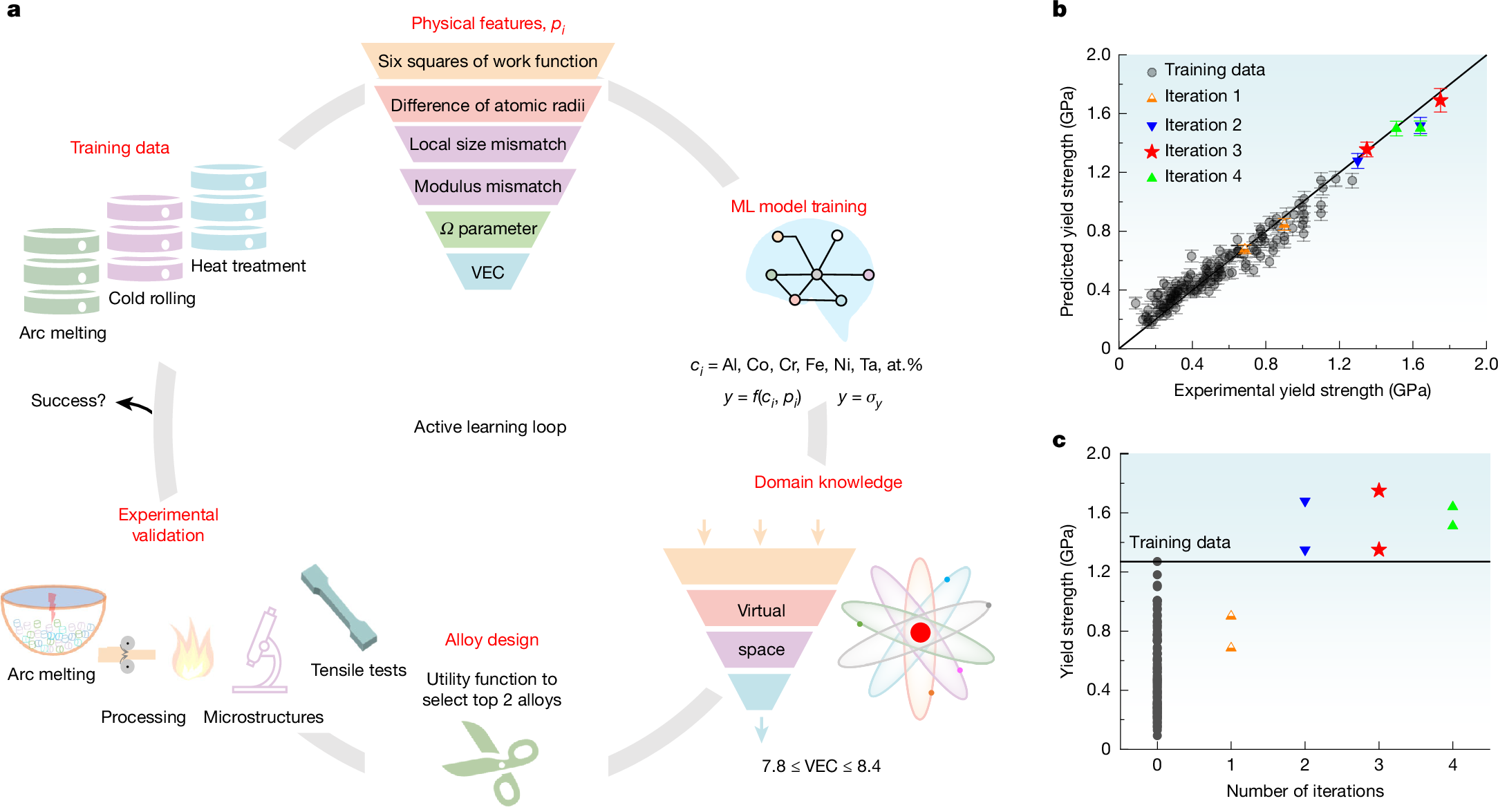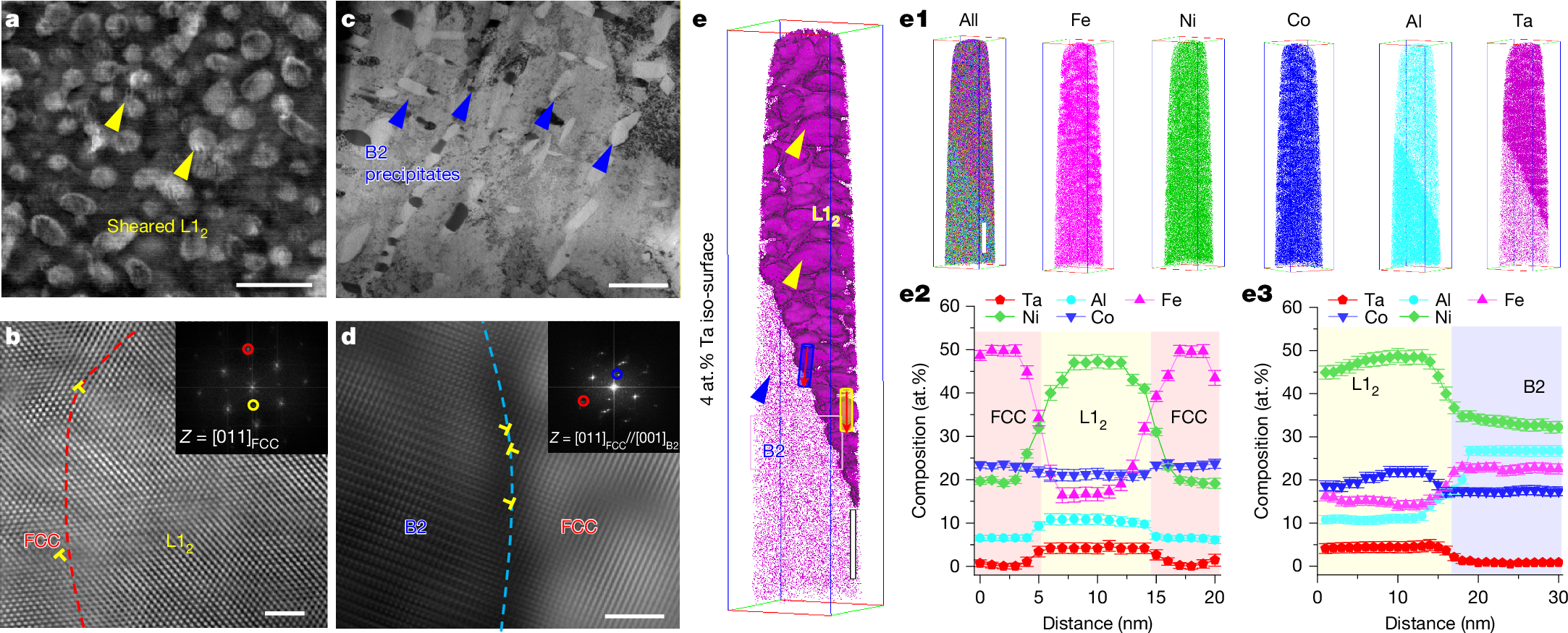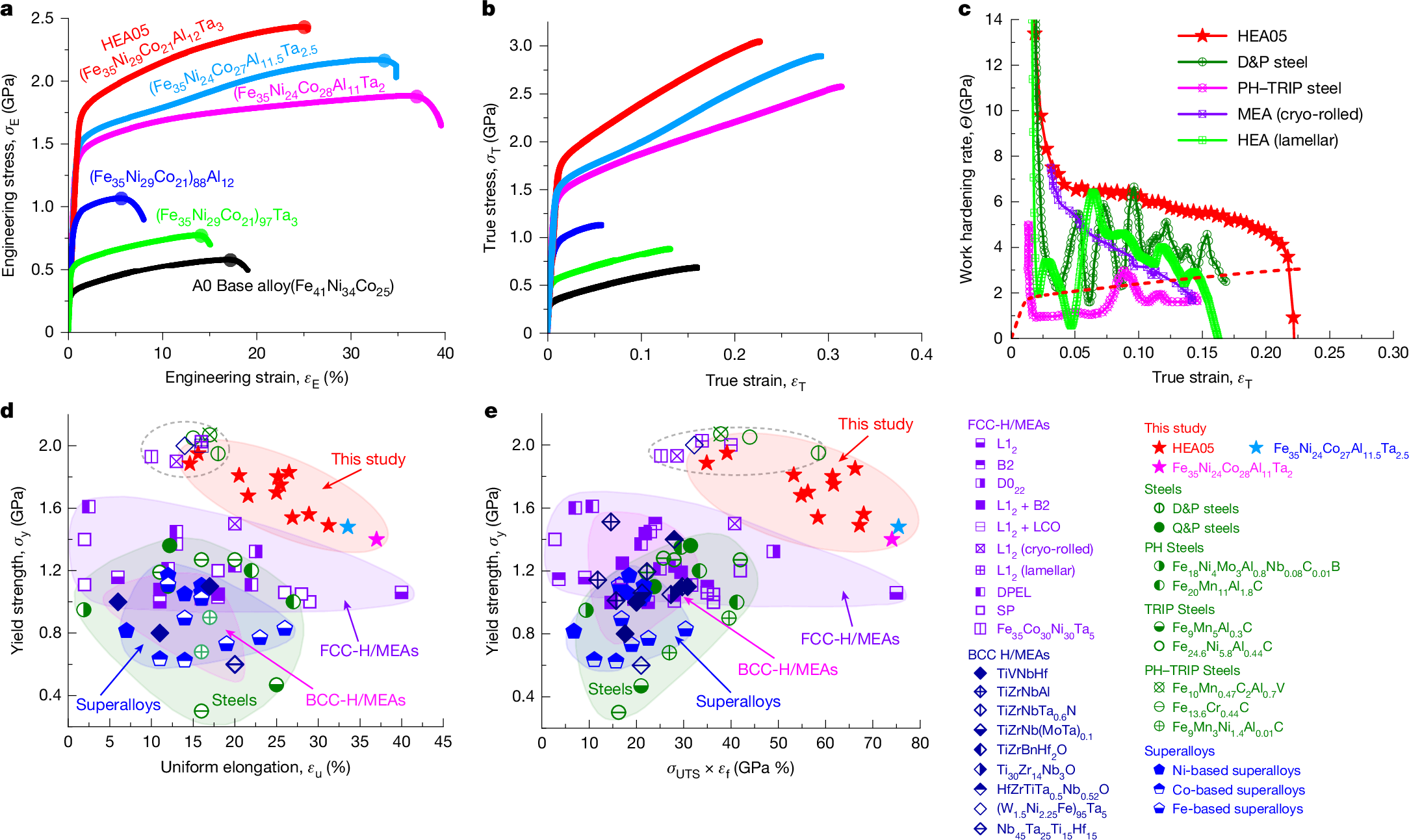Machine-learning design of ductile 2-GPa Alloys
The pursuit for strong-yet-ductile alloys has been ongoing for centuries. However, for all the alloys developed thus far, including recent high-entropy alloys, those possessing good tensile ductility rarely approach 2 GPa yield strength at room temperature. The few that do are mostly ultrastrong steels; however, their stress-strain curves exhibit plateaus and serrations, as their tensile flow actually suffers from plastic instability (such as Lüders strains), and the elongation is pseudo-uniform at best. Moreover, even when such instabilities are minimized, as in certain maraging steels, their uniform elongation (εu) remains disappointingly low (~3.8%). A promising strategy to overcome these limitations involves leveraging the compositional complexity of high/medium-entropy alloys (H/MEAs), which can incorporate solute atoms, grain boundaries, twin boundaries, and nanoprecipitates to enhance mechanical performance. However, despite the use of nanoprecipitation and microstructural refinement, most H/MEAs still fail to surpass a σy of 1.2 GPa due to inadequate precipitate volume fractions or reliance on complex and impractical processing techniques like cryo-rolling. While a few exceptions, such as a heterogeneous CoCrNi-based alloy and lamellar-structured HEAs, have demonstrated near-2 GPa strength with reasonable elongation, their ductility is often pseudo-uniform and dominated by localized strain bands. Thus, despite considerable progress, a truly uniform and simultaneously high-strength (~2 GPa) H/MEA remains elusive, highlighting a critical gap in the development of next-generation structural materials.
To address these challenges, Dr. Yasir Sohail, under the supervision of Prof. Jinyu Zhang (XJTU), along with his team members, applied domain-specific knowledge to narrow the design space and enhance the performance of a machine learning (ML) model. As a result, a multi-principal-element alloy (MPEA) with the composition Fe35Ni29Co21Al12Ta3 was identified. Subsequent post-casting processing, involving various rolling and heat treatment parameters, successfully achieved the targeted mechanical properties. The resulting yield strength–uniform ductility combinations ranged from (1.5 GPa, 31%) to (1.95 GPa, 15%), reaching a performance domain previously inaccessible to bulk alloys. A prominent example, discussed in detail below, demonstrates a yield strength (σy) of 1.75 GPa, ultimate tensile strength (σUTS) of 2.4 GPa (with a corresponding true stress as high as 3 GPa), a high work-hardening rate (WHR, Θ) sustained above 2 GPa, and a uniform elongation (εu) of 25%. The microstructure contains a high volume fraction of coherent L12 (67 vol.%) and incoherent deformable B2 (15 vol.%) embedded in an FCC matrix. The latter, being multi-component with a reduced chemical ordering energy, is a deformable phase that accumulates dislocations inside to help sustain a high strain hardening rate that prolongs uniform elongation.

Figure 1: (a) Domain knowledge-based machine learning model (active learning loop consisting of six steps) predicting FeNiCoAlTa complex alloy with superb plasticity, (b) theoretical prediction of yield strength matching with experimental measurement of yield strength confirming the reliability of the machine learning model, and (c) experimental measurement of yield strength versus the number of iterations of the model, which reveals the optimal composition of the Fe35Ni29Co21Al12Ta3 complex alloy.

Figure 2. (a-d) Room temperature deformation and interfacial characteristics of Fe35Ni29Co21Al12Ta3 complex alloy with triplex structure, i.e., dislocations are able to cut through the L12 nanoparticle and are stored in the low-modulus B2 micrometer phase, and dislocations are present at both the L12/FCC coherent interphase and the B2/FCC non-coherent interfaces; (e) Atom probe analysis of the chemical composition and distribution characteristics of the complex alloy, and the elemental composition of the multicomponent L12 nanoparticle and B2 micrometer phase.

Figure 3. (a-b) Engineering stress-strain and true stress-strain curves of complex alloys with different compositions, (c) work-hardening properties of Fe35Ni29Co21Al12Ta3 complex alloy in comparison with other 2GPa-class ultra-high-strength metallic materials (D&P steels, martensitic steels, and medium- and high-entropy alloys), (d, e) Fe35Ni29Co21Al12Ta3 complex The yield strength-uniform tensile elongation comparisons and yield strength-product of tensile strength with elongation comparisons of the alloys significantly outperform the combination of room-temperature mechanical properties of other metallic materials reported so far when compared with other metallic materials.
The research results are published online in Nature under the title “Machine-learning design of ductile FeNiCoAlTa alloys with high strength.” This work is the first Nature article independently produced by the School of Materials Science and Engineering of Xi'an Jiaotong University, China.
First author: Dr. Yasir Sohail, Xi'an Jiaotong University.
Corresponding authors: Prof. Zhang Jinyu, Prof. Ma En, and Academician Sun Jun.
Corresponding institution: National Key Laboratory for Mechanical Behavior of Materials, Xi'an Jiaotong University, Xi'an, China.
For correspondence: yasirsohail@stu.xjtu.edu.cn
Paper Link: https://www.nature.com/articles/s41586-025-09160-2
Follow the Topic
-
Nature

A weekly international journal publishing the finest peer-reviewed research in all fields of science and technology on the basis of its originality, importance, interdisciplinary interest, timeliness, accessibility, elegance and surprising conclusions.


Please sign in or register for FREE
If you are a registered user on Research Communities by Springer Nature, please sign in